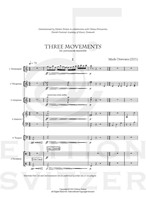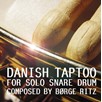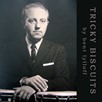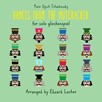
Three Movements
Composer: Mads Drewsen
Instrument: Percussion Ensemble
Level: Intermediate/Advanced
Published: 2022
Price: €70.00
Item details
-
Description +
-
Duration: 15 min.
Preface
Three Movements is written based on the idea that students at all levels can enjoy playing together. There are challenges on many levels, but also quite simple parts. Hopefully, this will benefit percussion ensembles at music school and conservatory preparatory levels. The idea is to further one’s experience so that one can advance to harder and more difficult parts.
Three Movements can be played by six to eight musicians. The percussion parts (the unpitched) can either be gathered together on a kind of drum set or handed out to as many musicians.
The musical style is strongly inspired by my own background and working day as a musician in an opera orchestra. Prokofiev, Shostakovich and Ravel have a big place in my heart and has inspired me through their tonal language (mostly in the second and third movements). The melodic style is a conscious choice to give, especially the very young, a motivation to learn the pieces and enjoy playing them.
-
-
Instrumentation +
-
Percussion Ensemble
Player 1: Glockenspiel & Castagnettes (3rd movement only)
Player 2: Vibraphone (without motor)
Player 3: Xylophone
Player 4: Marimba (4.3 octave)*
Player 5: 4 Timpani (G-C-D-E)
Player 6-8: Snare Drum, Suspended Cymbal/A2 & Gran Cassa
Player 9-11: Tamburin, Triangle & Woodblock**
*) 1st and 2nd mvt. can be performed by either one or two players
**) can be performed by either one or two players. If played by one player, the tambourine can be mounted on a table.
-
-
About the composer +
-
Born in Haderslev, Southern Jutland in 1974, Mads moved to Copenhagen in 1990 to apply for entry at the Royal Danish Academy of Music. There, he studied from 1991 to 1997 under Professor Bent Lylloff and at the same time received lessons from Søren Monrad (The Royal Danish Orchestra), Poul Leerhøj (Danish National Symphony Orchestra) and Morten Friis (Safri Duo). He also studied with Daniel Druckman in 1996, percussionist of the New York Philharmonic and teacher at the Julliard School of Music.
Mads has always had great focus on orchestral music and chamber music. He started very early to assist in the Copenhagen Symphony Orchestras and has participated in many chamber music contexts, small and large. With larger projects, he performed in two large percussion concerts that the Royal Danish Orchestra’s Percussion Group played in 2015 and 2016 on the Big Stage at the Opera and the Old Stage at the Royal Theater. The aforementioned concert premiered Søren Monrad's Mechanics and Tobias Broström's Stellar Horizons, both of which are also written for the Royal Danish Orchestra’s Percussion Group.
As an educator, Mads has been a part-time teacher at both the Danish National Academy of Music and the Royal Danish Academy of Music. Has also taught a number of private students.
In 1997, Mads was permanently employed in the Royal Opera, where he has played ever since. He made a short detour to the Odense Symphony Orchestra in the 2006/2007 season.
-
-
Reviews +
-
Review (Percussive Notes, June 2022)
Commissioned by Edition Svitzer in collaboration with Odense Percussion and the Danish National Academy of Music, “Three Movements” is a 15-minute work that will present a professional-level challenge to keyboard percussion players and a moderate challenge to those playing the timpani and percussion parts. Mads Drewsen has scored the work in a manner similar to an orchestral percussion section, drawing comparison to the large ensemble works of Thomas Gauger. He states that inspiration for the work comes from his background working in an opera orchestra, and the music of Prokofiev, Shostakovich, and Ravel.
The first movement is perhaps the easiest, frequently shifting between slow and moderate tempos, and ending with a quick burst at 120 bpm in the final seven measures. The second movement begins with a soft and distant slow march from the percussion and counterpoint between the keyboard parts, before exploding into a quick 142 bpm, marked by sixteenth-note runs in melodic voices, which dominates most of the movement. The final movement begins as a spritely gallop at 152 bpm with a plethora of sixteenth-note figures in the keyboards and supportive writing in the timpani and percussion. A brief middle section offers a slight reprieve with a slower tempo and spacious rhythms, but this soon yields to an accelerando that culminates in a blisteringly fast final section.
The composer offers accommodations in assigning the parts. For example, the percussion part can be divided between multiple players, and the marimba part (the only instrument requiring four mallets) can be split between two players (assumingly treble and bass clef) in the first two movements. However, there is a passage that occurs at several places in the third movement, featuring sixteenth notes in the treble clef and a descending line in the bass clef, that would most certainly merit splitting the part. In addition to being very fast, the keyboard writing often features significant leaps that would require a mature player to navigate the appropriate sticking.
The non-pitched percussion scoring is rather straightforward, with figures playable by intermediate players in a student orchestra or wind ensemble. Despite its important role in supporting the ensemble, the timpani part consists of mostly quarter and eighth-note rhythms and does not change pitches, maintaining a G-C-D-E tuning throughout all three movements.
Due to its length, difficulty, and scoring, this could easily be considered a “percussion symphony.” While less-experienced groups are cautioned before taking this on, it is certainly not impossible, provided the appropriate players are enlisted. The live recording on the Edition Svitzer website proves this point.
—Jason Baker
-
-
Credits +
-
Front Cover Design: Ronni Kot Wenzell
Photo: Henrik Bang Termansen
Printed in Copenhagen, Denmark
Copyright © Edition SVITZER
www.editionsvitzer.com
-








